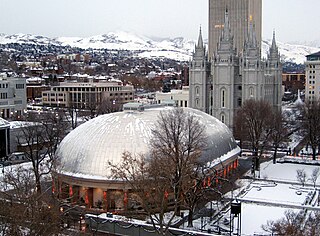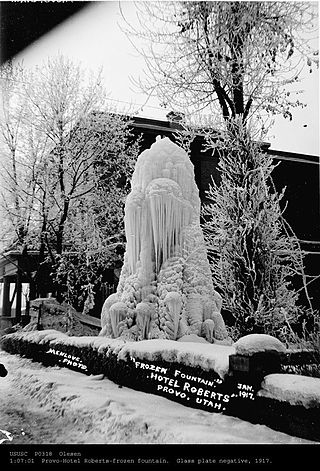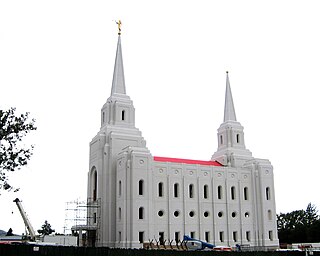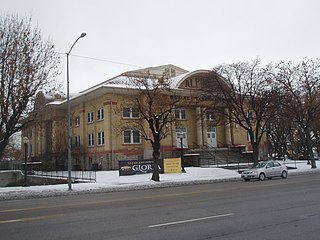
Temple Square is a 10-acre (4.0 ha) complex, owned by the Church of Jesus Christ of Latter-day Saints, in the center of Salt Lake City, Utah. The usage of the name has gradually changed to include several other church facilities that are immediately adjacent to Temple Square. Contained within Temple Square are the Salt Lake Temple, Salt Lake Tabernacle, Salt Lake Assembly Hall, the Seagull Monument, and two visitors' centers. The square was designated a National Historic Landmark District in 1964, recognizing the Mormon achievement in the settlement of Utah.
William Harrison Folsom was an architect and contractor. He constructed many of the historic buildings in Utah, particularly in Salt Lake City. Many of his most prominent works were commissioned by the Church of Jesus Christ of Latter-day Saints. For a time he was sustained as the Church Architect, a calling in the church.

The Conference Center, in Salt Lake City, Utah, is the premier meeting hall for the Church of Jesus Christ of Latter-day Saints. Completed in 2000, the 21,000-seat Conference Center replaced the traditional use of the nearby Salt Lake Tabernacle, built in 1868, for the church's biannual general conference and other major gatherings, devotionals, and events.

The Salt Lake Tabernacle, formerly known as the Mormon Tabernacle, is located on Temple Square in Salt Lake City, in the U.S. state of Utah. The Tabernacle was built from 1863 to 1875 to house meetings for the Church of Jesus Christ of Latter-day Saints. It was the location of the church's semi-annual general conference until the meeting was moved to the new and larger LDS Conference Center in 2000. Now a historic building on Temple Square, the Salt Lake Tabernacle is still used for overflow crowds during general conference. It is renowned for its remarkable acoustics and iconic pipe organ. The Tabernacle Choir has performed there for over 100 years.

The Vernal Utah Temple is the fifty-first temple of the Church of Jesus Christ of Latter-day Saints. The temple is located in Vernal and was the church's tenth temple built in Utah.

The Provo Utah Temple was a temple of the Church of Jesus Christ of Latter-day Saints located in Provo, Utah, just north of Brigham Young University (BYU). The intent to build the temple was announced on August 14, 1967, by Hugh B. Brown and N. Eldon Tanner. The church's temples are a sacred space where church members make covenants and perform ordinances for themselves and their deceased ancestors. The temple was designed by architect Emil B. Fetzer and was dedicated in 1972 as the church's seventeenth constructed and fifteenth operating temple. It was the sixth temple built in Utah, and the first in both Utah County and Provo.

The Ogden Utah Temple is the sixteenth constructed and fourteenth operating temple of the Church of Jesus Christ of Latter-day Saints. Located in Ogden, Utah, it was originally built with a modern, single-spire design, similar to the Provo Utah Temple. The temples in Ogden and Provo were designed to be sister temples and are the only ones dedicated by church president Joseph Fielding Smith. The temple became the church’s fifth in Utah, and second along the Wasatch Front, dedicated almost 79 years after the Salt Lake Temple. It was the first to be dedicated in the state of Utah, as the previous ones were dedicated when Utah was still a territory.

Hotel Roberts was a historic hotel located in central Provo, Utah, United States, that was formerly listed on the National Register of Historic Places.

Minerva Bernetta Kohlhepp Teichert was a 20th-century American artist who painted Western and Mormon subjects, including murals of scenes from the Book of Mormon. She received her art education from the Art Institute of Chicago and the Art Students League of New York, and was a member of the Church of Jesus Christ of Latter-day Saints. Religious-themed artwork by Teichert includes Christ in a Red Robe, Queen Esther, and Rescue of the Lost Lamb. She painted 42 murals related to stories in the Book of Mormon which reside in Brigham Young University's (BYU) Museum of Art. Teichert was the first woman invited to paint a mural for an LDS Church temple.
Richard Eyring "Rick" Turley Jr. is an American historian and genealogist. He previously served as both an Assistant Church Historian of the Church of Jesus Christ of Latter-day Saints and as managing director of the church's public affairs department.

The Church of Jesus Christ of Latter-day Saints in California refers to the Church of Jesus Christ of Latter-day Saints and its members in California. California has the 2nd most members of the LDS Church in the United States, behind Utah. The LDS Church is the 2nd largest denomination in California, behind the Roman Catholic Church.

The Church of Jesus Christ of Latter-day Saints in Utah refers to the Church of Jesus Christ of Latter-day Saints and its members in Utah. Utah has more church members than any other U.S. state or country. The LDS Church is also the largest denomination in Utah.

The Brigham City Utah Temple is a temple of the Church of Jesus Christ of Latter-day Saints in Brigham City, Utah. The temple was announced by church president Thomas S. Monson on October 3, 2009, during the church's general conference. The temple was announced concurrently with those to be constructed in Concepción, Chile, Fort Lauderdale, Florida, Fortaleza, Brazil and Sapporo, Japan; at the time, the announcement brought the total number of temples worldwide to 151. It is the fourteenth temple of the LDS Church completed in Utah.

The Logan Tabernacle is a tabernacle of the Church of Jesus Christ of Latter-day Saints and is located in Logan, Cache County, Utah. It is used regularly for church meetings, most often semi-annual stake conferences, seminary graduations, musical concerts, and lectures. The tabernacle welcomes visitors and is open for tours each summer from June to September. It is the site of many local celebrations, including the city's annual Summerfest Arts Faire held each June on the tabernacle grounds.

In the Church of Jesus Christ of Latter-day Saints, a tabernacle is a multipurpose religious building, used for church services and conferences, and as community centers. Tabernacles were typically built as endeavors of multiple congregations, usually at the stake level. They differ from meetinghouses in scale and differ from temples in purpose.

The Provo City Center Temple is a temple of the Church of Jesus Christ of Latter-day Saints, built on the site of the former Provo Tabernacle in Provo, Utah. Completed in 2016, the temple uses much of the external shell of the tabernacle that remained from the original building after a fire in December 2010. The intent to build the temple was announced on October 1, 2011, by church president Thomas S. Monson, during the church's general conference. The temple is the second in Provo, was the sixteenth in Utah, and the church's 150th worldwide. This temple has a distinctive exterior with Gothic-inspired stained glass windows. A groundbreaking ceremony, to signify the beginning of construction, was held on May 12, 2012, conducted by Jeffrey R. Holland.

The current Box Elder Stake Tabernacle, also known as the Brigham City Tabernacle, is a neo-Gothic tabernacle of the Church of Jesus Christ of Latter-day Saints rebuilt in Brigham City, Box Elder County, Utah by Mormon pioneers in 1897 after being gutted by fire a year earlier. The tabernacle continues to function as a meetinghouse for congregants of the Box Elder Stake and seats approximately 1,600. It also hosts concerts and other special events and is open for tours during the summer. Given its unique architecture and importance to the community, the tabernacle was listed on the National Register of Historic Places on May 14, 1971. The temple, built in 2012, stands across from the tabernacle.

The Alpine Stake Tabernacle or Alpine Tabernacle, located at 110 East Main Street (US-89) in American Fork, Utah, United States, functions as a meeting place for large gatherings of members of the Church of Jesus Christ of Latter-day Saints in northern Utah County for worship services. The building is part of the American Fork Historic District listed on the National Register of Historic Places.

The Granite Stake Tabernacle is a tabernacle of the Church of Jesus Christ of Latter-day Saints in the Sugar House District of Salt Lake City, Utah, United States. It has historic significance to the area and was listed in the U.S. National Register of Historic Places in 2003.

The Weber Stake Tabernacle, later known as the Ogden Pioneer Tabernacle, was a tabernacle belonging to the Church of Jesus Christ of Latter-day Saints. The tabernacle was constructed by Latter-day Saints in Ogden, Utah during the 1850s. The building stood for over one-hundred years, until it was razed in 1971 to make way for the Ogden Utah Temple.























